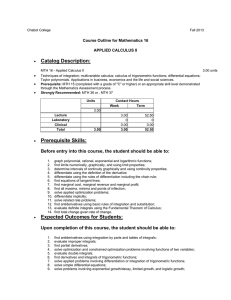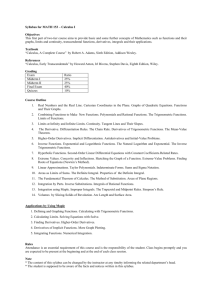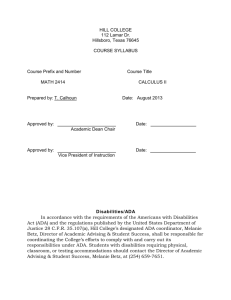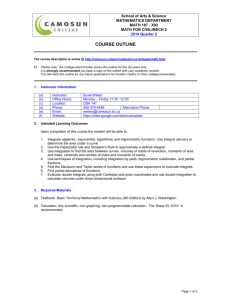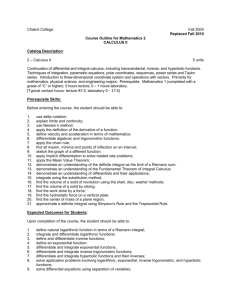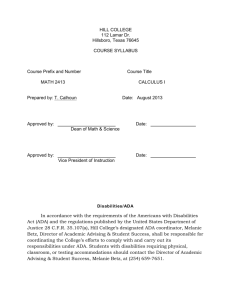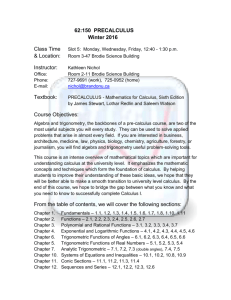Applied Calculus II
advertisement
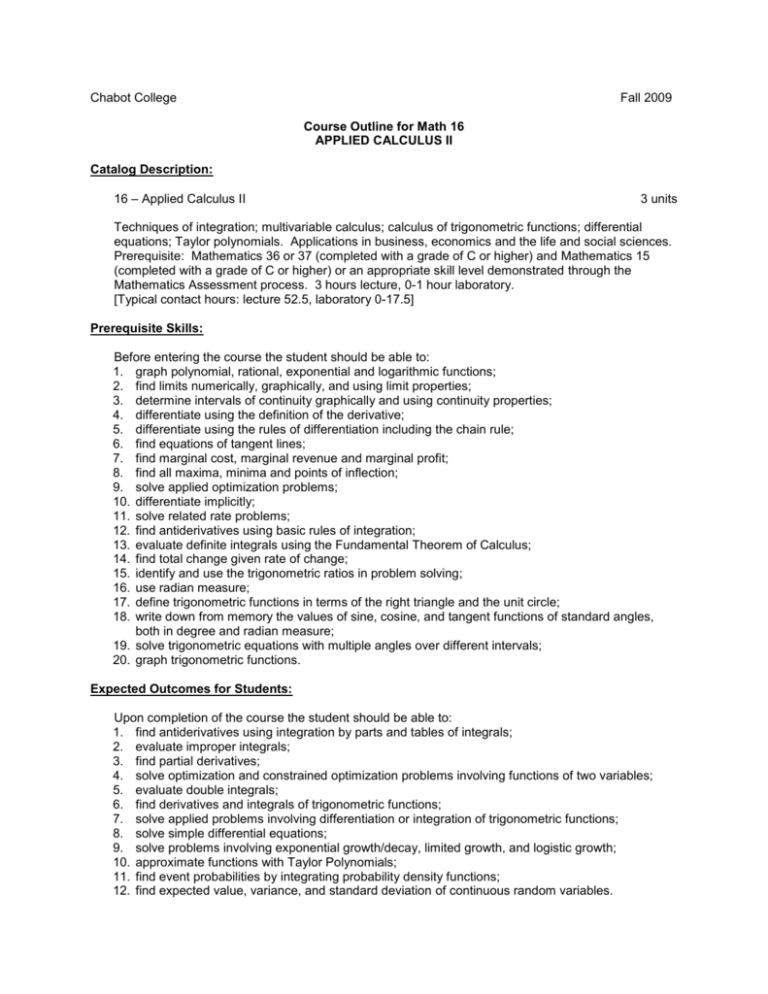
Chabot College Fall 2009 Course Outline for Math 16 APPLIED CALCULUS II Catalog Description: 16 – Applied Calculus II 3 units Techniques of integration; multivariable calculus; calculus of trigonometric functions; differential equations; Taylor polynomials. Applications in business, economics and the life and social sciences. Prerequisite: Mathematics 36 or 37 (completed with a grade of C or higher) and Mathematics 15 (completed with a grade of C or higher) or an appropriate skill level demonstrated through the Mathematics Assessment process. 3 hours lecture, 0-1 hour laboratory. [Typical contact hours: lecture 52.5, laboratory 0-17.5] Prerequisite Skills: Before entering the course the student should be able to: 1. graph polynomial, rational, exponential and logarithmic functions; 2. find limits numerically, graphically, and using limit properties; 3. determine intervals of continuity graphically and using continuity properties; 4. differentiate using the definition of the derivative; 5. differentiate using the rules of differentiation including the chain rule; 6. find equations of tangent lines; 7. find marginal cost, marginal revenue and marginal profit; 8. find all maxima, minima and points of inflection; 9. solve applied optimization problems; 10. differentiate implicitly; 11. solve related rate problems; 12. find antiderivatives using basic rules of integration; 13. evaluate definite integrals using the Fundamental Theorem of Calculus; 14. find total change given rate of change; 15. identify and use the trigonometric ratios in problem solving; 16. use radian measure; 17. define trigonometric functions in terms of the right triangle and the unit circle; 18. write down from memory the values of sine, cosine, and tangent functions of standard angles, both in degree and radian measure; 19. solve trigonometric equations with multiple angles over different intervals; 20. graph trigonometric functions. Expected Outcomes for Students: Upon completion of the course the student should be able to: 1. find antiderivatives using integration by parts and tables of integrals; 2. evaluate improper integrals; 3. find partial derivatives; 4. solve optimization and constrained optimization problems involving functions of two variables; 5. evaluate double integrals; 6. find derivatives and integrals of trigonometric functions; 7. solve applied problems involving differentiation or integration of trigonometric functions; 8. solve simple differential equations; 9. solve problems involving exponential growth/decay, limited growth, and logistic growth; 10. approximate functions with Taylor Polynomials; 11. find event probabilities by integrating probability density functions; 12. find expected value, variance, and standard deviation of continuous random variables. Chabot College Course Outline for Mathematics 16, page 2 Fall 2009 Course Content: 1. Integration Techniques a. Integration by parts b. Integration using tables c. Applications d. Improper integrals 2. Multivariable Calculus a. Functions of several variables b. Partial derivatives c. Optimization and constrained optimization d. Double integrals e. Applications 3. Trigonometric Functions a. Review definitions of trigonometric functions b. Derivatives of trigonometric functions c. Integrals of trigonometric functions d. Applications 4. Differential Equations a. Solutions of differential equations b. Separation of variables c. Applications 5. Taylor Polynomials 6. Probability and Calculus a. Probability distributions b. Expected value and variance c. Methods of Presentation: 1. Lectures 2. Problem Solving 3. Discussions Assignments and Methods of Evaluating Student Progress: 1. Typical Assignments a. The concentration (in mg/mL) of a certain drug in a patient’s bloodstream t hours after it has been administered is given by C(t ) 3tet / 3 Find the average concentration of the drug in the patient’s bloodstream over the first 12 hours after administration. b. A company produces two types of desks, x finished desks and y unfinished desks per week. The total weekly profit (in dollars) is given by the profit function P( x, y) 0.2x2 0.25 y 2 0.2xy 100x 90 y 4000 If the company’s management decides to restrict the production of these desks to a total of 200 desks per week, how many finished desks and how many unfinished desks should be produced each week to maximize the company’s weekly profit? Chabot College Course Outline for Mathematics 16, page 3 Fall 2009 c. The life span of a certain plant species (in days) is described by the probability density function 1 x / 100 f ( x) e 100 Find the probability that a plant of this species will live for 100 days or less. d. The weekly closing price (in dollars per share) of XYZ Corporation stock in week t is approximated by t f (t ) 80 3t cos 0 t 15 6 Find the average closing price of the stock over the 15-week period. 2. Methods of Evaluating Student Progress a. Homework b. Quizzes c. Exams d. Final Examination Textbook(s) (Typical): Applied Calculus, Soo Tan, Brooks Cole, 2008 Special Student Materials: Scientific or graphing calculator DC 10/2008
